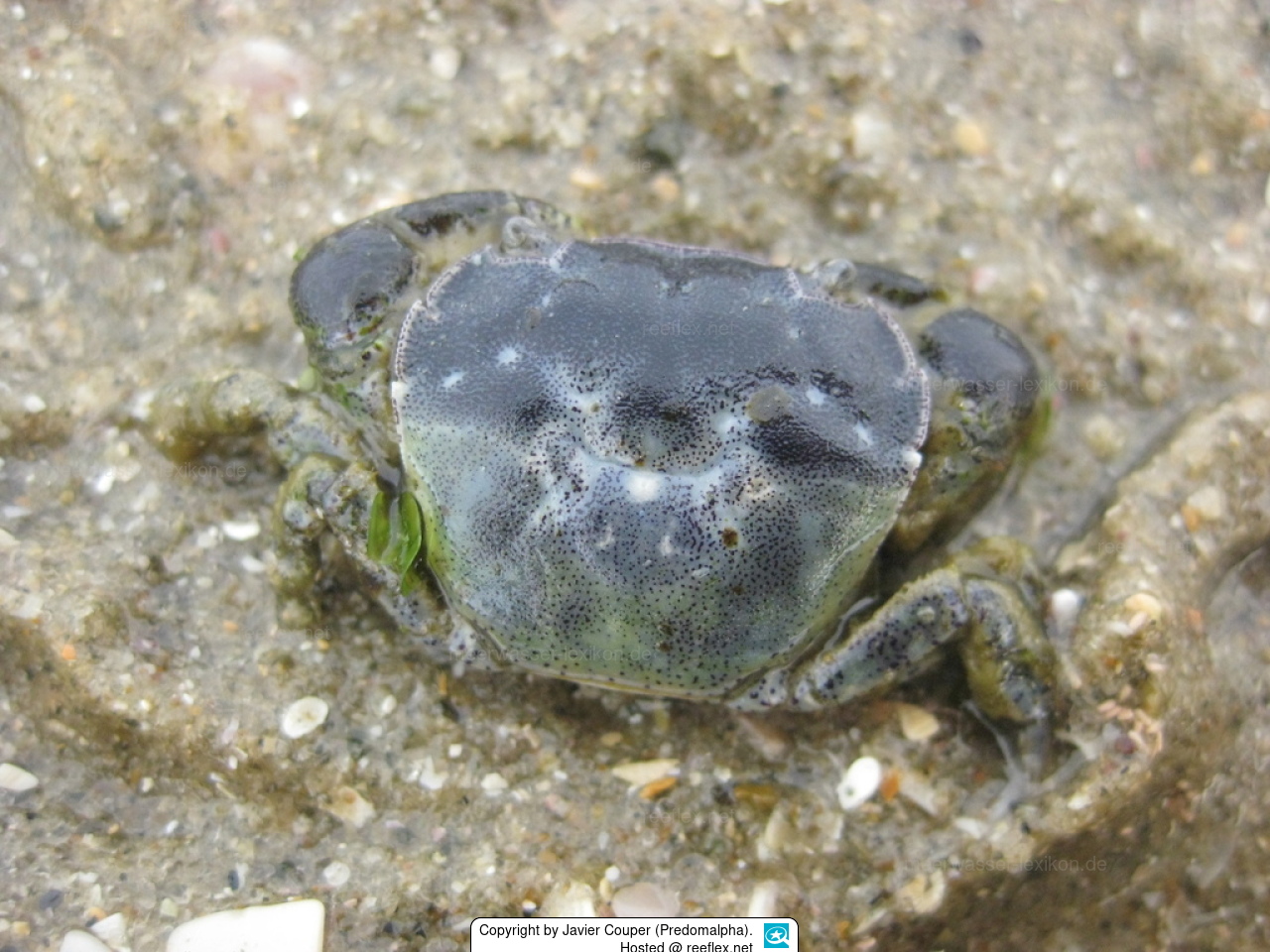Info
Hemigrapsus crenulatus (H. Milne Edwards, 1837)
Carapace smooth, flattened, square with two teeth on both sides. The front of the carapace is cut straight between the eyestalks. Inner surface of the scissors in males with dense hair.
The legs are flattened and hairy at the edges. Carapace greenish-yellow with white spots, covered with purple or reddish-brown spots (or may be more purple with white spots). Eye stalks white. The dorsal surface of the scissors is dark brown/purple, the scissor fingers are white with dark brown tips and lined with short, fine bristles.
Widespread in New Zealand, including Stewart Island. Also southern Chile. Found in a variety of habitats including under rocks, buried in sand, mud or clay, in protected marine and marine areas and estuarine environments. It is a tidal species with semiterrestrial tendencies. It is named for its characteristic bristles or thick tufts of hair on its scissor arms and walking legs.
The spawning season extends from June to January or February, with winter breeding occurring more frequently than summer breeding.
Hemigrapsus crenulatus occurs throughout mainland New Zealand and on the west coast of Chile. It is euryhaline, meaning it can survive in environments with a wide range of salinities. These include estuaries, brackish waters and tidal waters.
Mary J. Rathbun was the first to compare specimens from New Zealand and Chile in 1918, supporting the traditional view of a single species. This view was confirmed by extensive morphological and genetic analysis in 2011.
Often in similar habitats as Austrohelice crassa and Hemiplax hirtipes. Mid-tide level up to 10 m.
There is a possibility of confusion with Hemigrapsus sexdentatus and Cyclograpsus lavauxi.
Synonymised names:
Cyclograpsus crenulatus H. Milne Edwards, 1837 · unaccepted > superseded combination
Heterograpsus barbigerus Heller, 1862 · unaccepted > junior subjective synonym
Heterograpsus barbimanus Heller, 1865 · unaccepted > junior subjective synonym
Heterograpsus crenulatus (H. Milne Edwards, 1837) · unaccepted > superseded combination
Heterograpsus sanguineus (De Haan, 1835) sensu Lenz, 1902 · unaccepted > misapplication
Trichodactylus granarius Nicolet in Gay, 1849 · unaccepted > junior subjective synonym
Trichodactylus granulatus A. Milne-Edwards, 1853 · unaccepted > misspelling (does not appear to exist outside...)
Carapace smooth, flattened, square with two teeth on both sides. The front of the carapace is cut straight between the eyestalks. Inner surface of the scissors in males with dense hair.
The legs are flattened and hairy at the edges. Carapace greenish-yellow with white spots, covered with purple or reddish-brown spots (or may be more purple with white spots). Eye stalks white. The dorsal surface of the scissors is dark brown/purple, the scissor fingers are white with dark brown tips and lined with short, fine bristles.
Widespread in New Zealand, including Stewart Island. Also southern Chile. Found in a variety of habitats including under rocks, buried in sand, mud or clay, in protected marine and marine areas and estuarine environments. It is a tidal species with semiterrestrial tendencies. It is named for its characteristic bristles or thick tufts of hair on its scissor arms and walking legs.
The spawning season extends from June to January or February, with winter breeding occurring more frequently than summer breeding.
Hemigrapsus crenulatus occurs throughout mainland New Zealand and on the west coast of Chile. It is euryhaline, meaning it can survive in environments with a wide range of salinities. These include estuaries, brackish waters and tidal waters.
Mary J. Rathbun was the first to compare specimens from New Zealand and Chile in 1918, supporting the traditional view of a single species. This view was confirmed by extensive morphological and genetic analysis in 2011.
Often in similar habitats as Austrohelice crassa and Hemiplax hirtipes. Mid-tide level up to 10 m.
There is a possibility of confusion with Hemigrapsus sexdentatus and Cyclograpsus lavauxi.
Synonymised names:
Cyclograpsus crenulatus H. Milne Edwards, 1837 · unaccepted > superseded combination
Heterograpsus barbigerus Heller, 1862 · unaccepted > junior subjective synonym
Heterograpsus barbimanus Heller, 1865 · unaccepted > junior subjective synonym
Heterograpsus crenulatus (H. Milne Edwards, 1837) · unaccepted > superseded combination
Heterograpsus sanguineus (De Haan, 1835) sensu Lenz, 1902 · unaccepted > misapplication
Trichodactylus granarius Nicolet in Gay, 1849 · unaccepted > junior subjective synonym
Trichodactylus granulatus A. Milne-Edwards, 1853 · unaccepted > misspelling (does not appear to exist outside...)







 Javier Couper (Predomalpha), New Zealand
Javier Couper (Predomalpha), New Zealand










